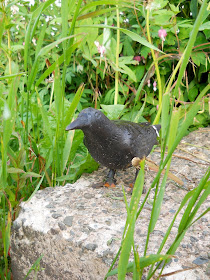How exciting, sharing a plant that others might not know, that I love. But what would that plant be? How can I possibly pick a favourite! There are so many plants and they all have so many uses and their particular place within my garden and my heart. Would it be a spring flower, heralding the new gardening year to come? or the brilliant blooms of summer basking in the heat? The trees providing shelter or the shrubs that provide the backdrop to the glowing colours of perennials? I took a look through some old photos for ideas and it turned out to be a trip down memory lane, looking at flowers of bygone gardens, it made me happy and sad and reminded me of how my gardening experience has grown over the past years.
My favourite plant it turns out is not something that is new and unknown, not exotic or sought after but something more personal. It is the simple and rather common Forget-Me-Not, or Myosotis alpestris.
Many people aren't terrible fond of this little flower or simply don't find it all that interesting. It can be found just about anywhere, will grow anywhere, self seeds readily and frequently all over the place. In fact, if you grow it you might find that it invades your garden in every nook and cranny.
For an experienced gardener this plant may not seem exciting but for a beginner, there is no greater flower. When I began to garden for myself, not so many years ago, I was looking for plants that liked shade and were easy to cultivate. I wanted to start my own seeds and after searching catalogues these delightful blue flowers fit the bill. The seeds cost very little and they germinated with almost no work. Despite the fact that I planted them too thickly and didn't thin them, and that I lacked proper lighting, these little seeds thrived and introduced me to the wonder of growing a plant from seed. Taking a tiny speck and watching it become a plant with leaves and flowers. These little flowers gave me the courage to try other seeds and when the others didn't work I still took heart that I was able to grow something. When they were transferred to the great outdoors I worried over them but it wasn't necessary. Just a scrap of dirt and a small amount of light and these plants expanded considerably. No flowers that first year but I was awarded by masses of blooms the following year. Blue blue blue, how could you not love that bright bright blue.
Not only did these plants flower with abandon they also tossed their seeds around on the wind. And the next year I was rewarded with the soft fuzzy leaves of forget-me-nots popping up in corners that I wouldn't have otherwise thought would support them. Throughout my years of shade gardening the forget-me-nots were always there, carpeting the ground with their soft leaves, sprinkling the ground with blue. A constant delight each spring providing a background to the late blooming bulbs and paving the way for other summer plants to take hold.
Can you see the forget-me-nots in the above photo providing a backdrop to these lovely pink Woodland Hyacinth (Hyacinthoides hispanica)?
The flowers of forget-me-nots are tiny, almost insignificant but massed their colour is eye catching and their ease of growth helped pave the way for me to spread my wings and become comfortable in my gardening abilities. This past summer while my mother visited she cleaned out an old planter in front of the house. Once the weeds were pulled we mulled over what to put inside. Mom asked if I had any seeds and sure enough, there was a packet of forget-me-nots. Within weeks the little seeds had pushed through the ground and formed plants. I look forward this year to spring when I'll continue to have my little blue flowers to remind me of past gardens and all that I've learned and will continue to learn in my garden.
Thank you to fer for suggesting this post and taking me down memory lane :)














































